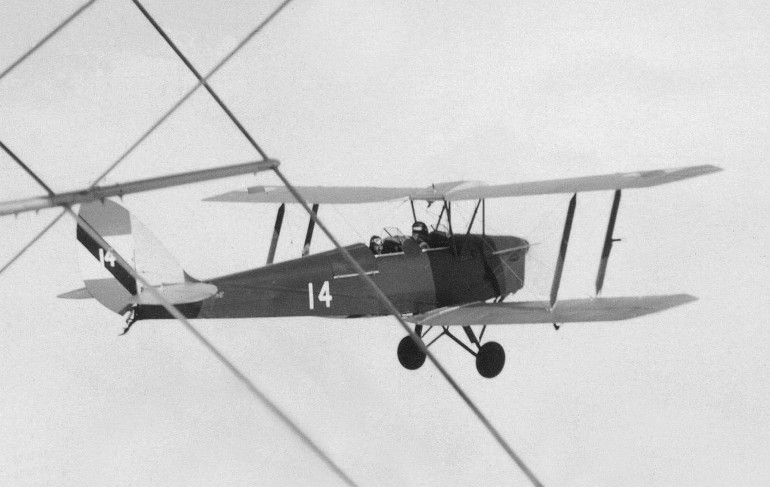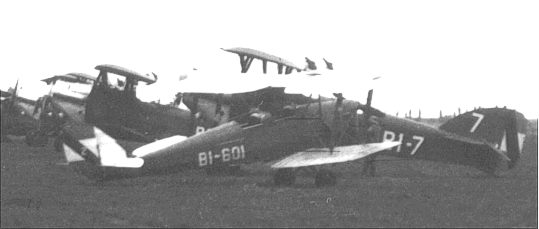|
Service
history
1941
1941 began with almost half the Tiger Moth fleet in the workshops.
Due to accidents the previous year, Nos.11 and 16 were still under
repair, whilst Nos 3, 5, 8, and 15 were taken in for overhaul taking
advantage of the teaching recess during January and February.
Even so,
during the summer months at the AMAer there was intense activity
including night flights by the Marine Guards and the pupils of the
Application Course.
In March the
three naval officers who had begun their course in 1939 finished
their training, returning to the Naval Aeronautical Service with 100
hours each flown in Tiger Moths.

No
14 (c/n 3616) photographed by the 2nd Lieut. Jaime Meregalli from
the other Tiger Moths at the beginning of 1940.
Photo Aeronautical Museum
April 1941 would be a highly significant date for the historical
evolution of Uruguayan Military Aeronautics.
Eighteen
Cadets from the most recently started Military School Aeronautics
Course, completed their first instructional flights in the DH82A.
(The author has had the privilege of hearing some wonderful stories
from the memories of Col. (Av) Atilio Bonelli, a member of that
first group of young aviators).
This month G/M
Gastón Larrañaga finished his course with 73 hours logged in the
DH82A.
Throughout
this year the Tiger Moths would be involved in a great deal of
activity.
Apart from the
normal courses conducted at the EMAer, additional exercises included
target towing for air-to-air firing by the Potez 25, shooting with
the camera-gun, instrument flight using the retractable hood over
the rear cockpit, dropping 15kg bombs, radio telegraphy, night
flight and navigation.
During the
display on August 25th 12 DH82As were in the air.
|
No |
Pilot |
No |
Pilot |
No |
Pilot |
| 3 |
Sgto.1º Hilario
Almandós |
8 |
Tte.1º Pedro
Iglesias |
14 |
Cap. Ramón Irazábal |
| 4 |
Tte.1º Eladio
Silvera |
9 |
Tte.1º Hugo Torre |
15 |
Sgto.1º
Víctor Luciano |
| 5 |
Sgto.
1º Alfonso Izarra |
12 |
Sgto.1º
Paulino Risso |
16 |
Tte.2º
Adail Altesor |
| 6 |
May.
Isaías Sánchez |
13 |
Cap.
Gustavo Bernadou |
17 |
Tte.2º Juan C.
Jorge |
DH82A Squadron in the aerial display of 25/8/41
On September 11, the General Director of Military Aeronautics
published Order No 6981 which included a redistribution of aircraft,
details of new paint schemes and insignia and establishing a new
system of serial numbering with three digits which has remained in
use until the present day.
| Matr.anterior |
2 |
3 |
4 |
5 |
6 |
8 |
9 |
11 |
12 |
13 |
14 |
15 |
16 |
17 |
| Matr.
nueva |
602 |
605 |
600 |
606 |
607 |
608 |
609 |
610 |
611 |
612 |
613 |
601 |
603 |
604 |
| Unidad |
BA2 |
D.S. |
BA1 |
EMA |
EMA |
EMA |
EMA |
EMA |
EMA |
EMA |
EMA |
BA1 |
BA2 |
BA2 |
The criteria adopted was to group the serials per flight unit
following the order A.B.1, A.B.2, Services, EMAer. From now on all
references will be to each aeroplane by its new serial number.
At the end of
September, Marine Guards Canfield and Mari finished their DH82A
instruction with 69 and 89 hours respectively, whilst M/G Larrañaga
had already finished in April.
Durante noviembre y a medida que van quedando prontos, realizan su Primer Vuelo Solo los primeros Cadetes aviadores.

Aircraft from Aeronautical Base No 1 on manoeuvres. In front of the
Potez 25 still displaying her old serial,
is the
DH82A 601 (ex 15), with the rudder lent by No 2, soon after the
publication of Order No 6981.
Los Cerillos, Canelones, December 1941. Photo Aeronautical
Museum.
1941 ended with the greatest number of hours yet flown by the Tiger
Moth fleet at a total of 3,242 hours. No 612 registered the most
with 422 hours of flight.
|